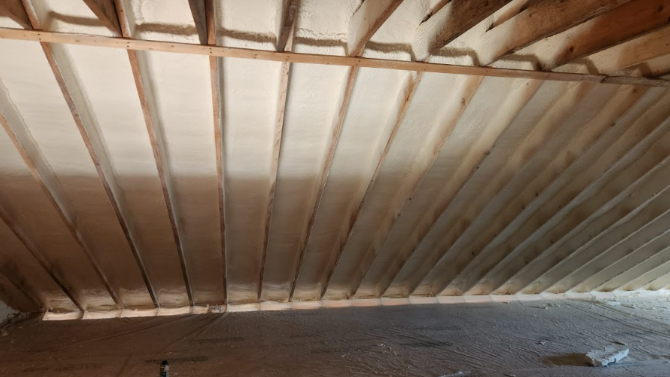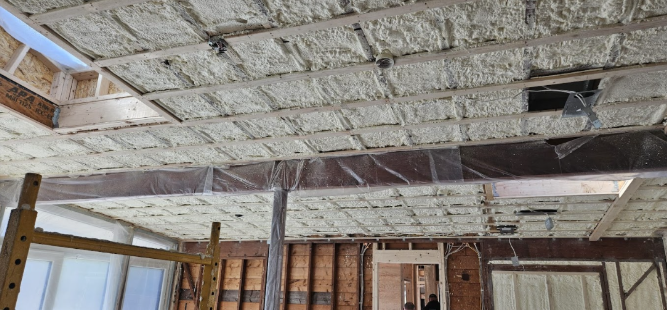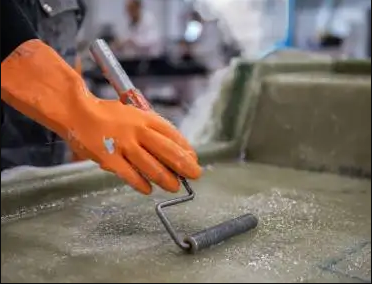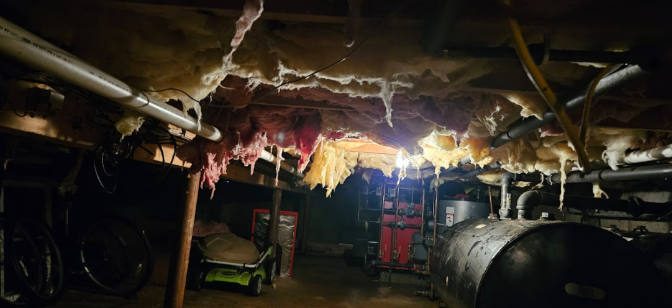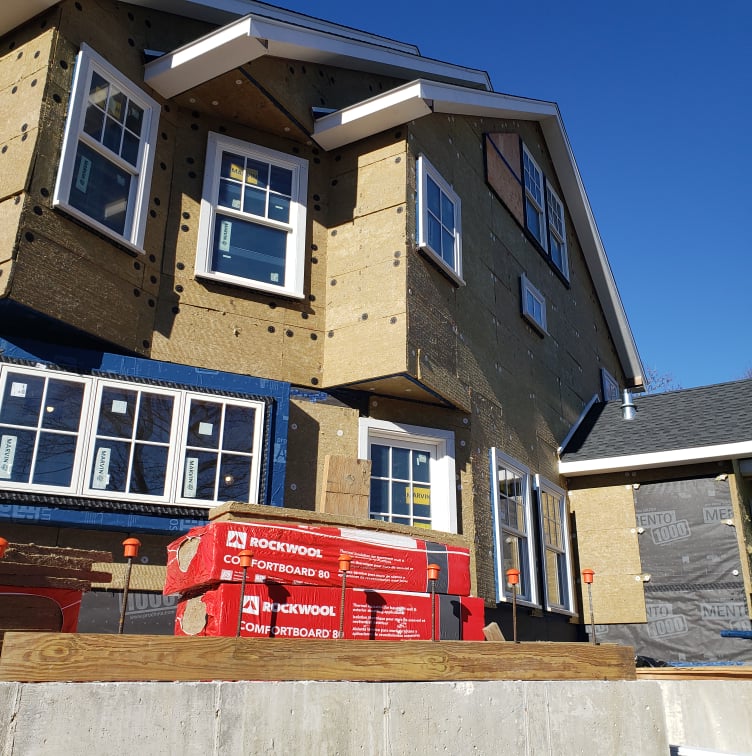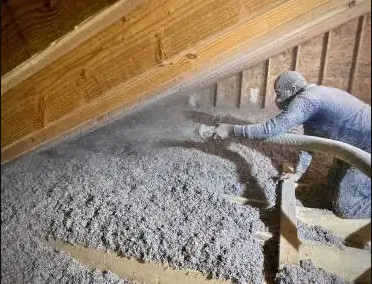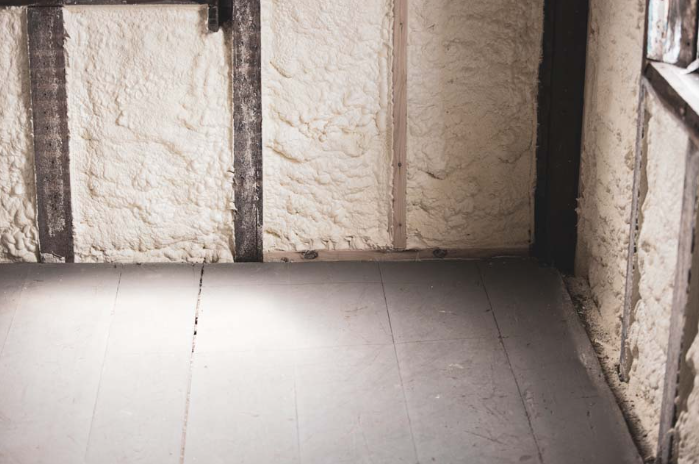Insulation plays a key role in your home’s energy efficiency, keeping indoor temperatures comfortable and energy bills low. But you may be wondering: What is R-value, and why does it matter in choosing the right insulation for your home? In this article, we will define the R-value, discuss how it relates to home insulation, and compare different insulation options, such as closed-cell spray foam vs open cell foam insulation.
Understanding R-Value
Fundamentally, R-value is a metric of an insulation material’s resistance to heat flow. (In other words, the higher the R-value, the better the material does at insulating and blocking heat transfer between your home’s interior and exterior.) R-value is calculated per inch of thickness; therefore, thicker, denser material usually has a higher R-value.
Think of R-value as a performance rating for insulation, like checking a car’s MPG to gauge fuel efficiency. It helps you determine how effective an insulation product will be at keeping your home warm in the winter and cool in the summer.
How Important Is R-Value in Insulation?
R-value is crucial because it directly impacts your home's energy efficiency, helping to maintain comfortable temperatures while reducing heating and cooling costs. Without insulation, heat will enter your home during the summer and the winter, and it escapes. Insulation works by preventing or slowing heat from entering or escaping. In cold months, it retains heat indoors; in warm months, it acts to repel heat from outside.
The R-value measures how well your insulation will control the temperature at home, so having a low R-value means your insulation won’t be as good at keeping your home at a temperature you like. This can result in higher energy bills, as you're heating and cooling systems will have to work harder to keep a comfortable temperature. However, higher R-value insulation can use better energy for the HVAC system and better production, so its use can reduce your energy bill in the long run!
Closed Cell Spray Foam vs Open Cell Foam Insulation
The R-value of insulation should be one of the most important factors you look at when selecting insulation. Not every material has the same R-value (a measure of insulation effectiveness), and two of the most common are closed-cell spray foam and open-cell foam insulation. These are pros and cons to each:
Closed Cell Spray Foam
Closed-cell spray foam is probably the best insulation material on the market today. It is a type of polyurethane material that, when introduced, expands to fill in all of the gaps, cracks, and voids in your home, creating a solid barrier. The R-value of rigid foam insulation is approximately 6.5 per inch, one of the highest of all products available to homeowners.
In addition, closed-cell spray insulation sets itself apart from open-cell foam as a superior choice since it acts as a moisture barrier, an air barrier, and even adds structural strength. Its dense structure provides a barrier for moisture, which restrains mold and water damage from penetrating through walls.
Open Cell Foam Insulation
On the other hand, open-cell foam insulation is less dense and lightweight, with an R-value of about 3.5 to 4 per inch. It’s still effective for insulating your home, but that level of heat resistance doesn’t reach the same capacity as closed-cell spray foam. Open cell foam additionally absorbs moisture, and if there happens to be mold or mildew growth, it could be in warm conditions.
That said, open-cell foam insulation has its benefits. More commonly used because it is also cheaper than closed-cell foam, it is lighter, which allows better soundproofing as well. It is an excellent option for interior areas like attics or interior walls, but it may not be the best bet for moist areas like basements or crawl spaces.
Considerations Beyond R-Value When Selecting Insulation
While R-value is an important factor, it’s not the only consideration when choosing insulation for your home. Here are a few other key factors to keep in mind:
Air Sealing Capabilities
Closed-cell insulation is particularly useful in achieving an air seal. It helps eliminate drafts and air leakages by plugging in small holes/ cracks on your walls, ceilings, and floors. This air-sealing quality greatly increases your home’s energy efficiency and in-home comfort.
Moisture Resistance
In addition to being air impermeable, however, one of the biggest advantages of closed-cell insulation is that it is resistant to moisture. Open-cell foam insulation can absorb moisture, leading to mold growth or water damage." If you live in a high-humidity area or an area where places like your basements or crawl spaces tend to be subject to water infiltration, closed-cell spray foam is likely what you want.
Durability and Longevity
It has better durability than open-cell spray foam, including long-term R-value retention. Unlike other insulation materials like fiberglass or cellulose, closed-cell foam will never sag or degrade, making it a long-term investment. Open-cell foam isn't as durable and needs to be replaced or maintained occasionally, though it is still effective.
Cost and Return on Investment
Closed-cell spray foam insulation is relatively more expensive initially in comparison to open-cell foam. However, due to its higher R-value and long-term energy savings, many homeowners discover it offers a strong return on investment. Ultimately, the upfront cost for installation can be offset over time through energy savings as heating and cooling costs decrease.
If you're concerned about the potential cost, consider reaching out to local insulation contractors. They can help you explore your options and provide estimates tailored to your home's specific needs.
You Must Have It Professionally Installed
Whether you go with closed-cell insulation or open-cell foam insulation, you need to make sure that you get your insulation installed by professionals with experience. Home insulation contractors will help you decide what type of insulation will work best in your home and install it correctly. Wrong installation can cause bad functioning, energy being lost, and an increased chance of moisture formation.
Most local insulation contractors will give you a free consultation to help you figure out your home’s needs and guide you through the installation process. Material choice is only part of the equation; proper installation is equally important — professional installers will have the tools and know-how to get it done right.
Conclusion: How Important Is R-Value, Really?
So, in short, yes—R-value is an important consideration when selecting insulation for your home. It gives you an intuitive idea of how well your insulation will resist heat flow. But R-value is only part of the story. Other factors like air sealing, moisture resistance, durability, and cost considerations also need to be part of the decision-making process.
Ultimately, the choice of insulation comes down to your home’s individual needs. Although some insulation contractors may try to convince you to go with either closed-cell spray foam or open-cell foam insulation, ultimately, half of the battle has been won simply by enlisting the help of experienced home insulation contractors.
Investing in high-quality insulation with a high R-value, such as a closed-cell spray foam system, ensures long-lasting energy savings and enhances comfort for your home. Contact your local insulation professionals and find out more about how you can improve your home’s energy efficiency with the best insulation.







